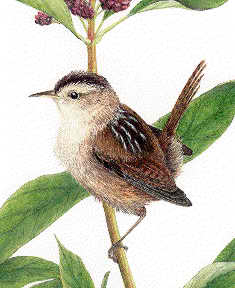Please Help Pets with a Small Donation of One Dollar
Wrens are small, restless birds, 4 to 8.75 inches. They are highly
vocal and in many species males and females sing duets. Wrens
have loud songs and dry scolding rattles.
Most wrens are found in pairs, but a number of tropical species
forage in flocks
They have a brownish coloring with finely barred, narrow and
rounded tails that are usually held upward. Bills are long and
slender.
Nesting habits vary; some build nests in natural or man-made hollows,
while others construct nests, often quite large, of twigs and grasses.
The male marsh wren of North America, often builds several "dummy nests"
before the female accepts one and the pair settles down to breed.
They lay 4 to 9 eggs.
The smallest North American wrens are the winter wren.
The most common is the house wren, is 5 in. It readily accepts nest boxes,
even close to houses, and due to it's aggressive nature will drive
other birds from nest boxes.
The cactus wren is the largest North American wren.
The bob-tailed wren is the only wren in Eurasia. In Great Britain,
it is known simply as wren, is common to woods, parks, and gardens.
Marsh Wren

Wrens belong to the order Passeriformes.
Wrens
Bewick's Wren
Cactus Wren
Canyon Wren
Carolina Wren
House Wren
Marsh Wren
Rock Wren
Sedge Wren
Winter Wren
Find out more on Perching Birds